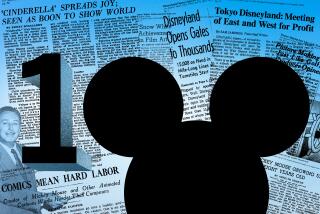Hallmark Celebrates Its 75th Birthday With Eyes on Future
- Share via
KANSAS CITY, Mo. — In January, 1910, a young Nebraska teen-ager named Joyce C. Hall arrived in Kansas City with two shoeboxes of picture postcards stuffed into a suitcase.
He didn’t waste any time setting up business at the local YMCA to wholesale his cards to dealers in the Midwest.
And through classic Horatio Alger-type persistence, hard work and an astute eye for public taste, Hall slowly established a framework that built a solid business that became a $1.5- billion greeting card company--Hallmark Cards Inc.
In gearing up for its 75th anniversary, Hallmark management is reflecting on the company’s humble beginnings--but with an eye toward the future and a carefully charted course designed to ensure “broader strength” and success against increasing competition.
“I think the anniversary is a great occasion,” said Hallmark Chairman and Chief Executive Donald J. Hall, who took the reins in 1983 following his father’s death in 1982.
“It’s brought about a lot of memories,” the 56-year-old Hall said. “I’ve had the chance to think back on things that have happened and our heritage.”
Sweeping changes in the company recently have led some observers to speculate that increased competition is the motivation behind the flurry of activity at corporate headquarters.
Last March Hallmark acquired W. N. Sharpe Holdings, a 114-year-old British manufacturer of greeting cards, for $52 million.
In August, the company announced it had acquired Binney & Smith, the manufacturer of Crayola crayons and other arts and crafts materials, for $204 million.
In October, Hallmark announced it was joining a venture formed to buy SFN Companies Inc., an Illinois-based publisher of textbooks and other educational materials.
And just last month it announced it had obtained majority ownership of a Minnesota-based Information Technology Design Associates Inc., a software firm that produces educational and entertainment programs for use by children on personal computers.
Greeting cards now constitute only half of Hallmark’s business.
Company officials stress the diversification is no more than a natural outgrowth of a firm continually re-evaluating its position as it enters a new age, and one that is constantly seeking ways to strengthen its financial base while staying on the “cutting edge” of the industry.
“They all fit into the pattern of a diversified company that is by far the leader in its industry,” said Christopher E. Clouser, corporate vice president for public affairs and communications.
“And it is our challenge to not only stay No. 1 but to continue to define this industry and lead it by a very significant margin.”
If Clouser sounds confident, he is only typical of the corporate optimism within the vast confines of Hallmark, where nary a discouraging word is heard--let alone spoken. It’s an upbeat atmosphere where words like “innovation” pop up frequently in conversation and “excellence” is the company’s watchword.
Executives will quickly play down the importance that competition has played in the firm’s past or present endeavors, but at the same time Clouser will say: “We like competition. We think it’s very healthy and I think extends our people into bigger and better accomplishments all the time.”
But, he is also quick to point out: “Diversification is not an effort tied to or contingent upon any competition.”
Company officials do admit the competition is there. What they will not tell you is that it has made much of a difference.
Says Charles W. Hucker, Hallmark’s director of corporate communications: “With the increased competition--and it’s there, there’s no doubt about it--our market share has not fallen off; it has grown.
“Now, so has American Greetings’. And people ask, ‘Well, how can both of you grow in market share at the same time?’ Well, it’s quite possible, we’re both doing it because it’s coming out of the smaller companies.”
According to Clouser, Hallmark commands more than 40% of the market share, with the figure having increased each year since the company was founded.
Its closest competitor, Cleveland-based American Greetings Corp., refused to disclose its share of the market, but said it recorded $840 million in revenues for fiscal 1984, which ended Feb. 29.
With annual sales of $1.5 billion, privately held Hallmark would rank mid-way among the nation’s top 500 publicly held companies in sales and book assets. But if measured by net income, it might fall among the upper quarter of those companies, and perhaps rank even higher if that income is computed as a percent of sales or equity.
Part of the legacy Joyce Hall left behind was property holdings, which now includes Crown Center, a residential and commercial complex that also houses Hallmark’s headquarters and a hotel.
One of the more significant areas in which Hallmark has recently concentrated--and one in which company officials see much promise for continual growth--is that of licensing properties.
Some observers have said American Greetings forced Hallmark into licensing with its 1980 introduction of the immensely popular Strawberry Shortcake doll.
Hallmark had been a licensee on several products, including Peanuts and Pac-Man greeting cards, but had owned no character-line property until introduction of the successful, but comparatively less lucrative Shirt Tales characters in 1982.
Then in February 1984, the firm introduced two new lines of character dolls--Rainbow Brite and Rose-Petal Place, geared for the lucrative juvenile-girls market.
The most ambitious research effort in Hallmark history came in mid-1984 with the launching of three new store concepts that will permit real-life testing of new products and marketing techniques. This past year, two stores were opened for each of the three new store concepts with more planned for 1985.
“Heartbeeps” is described by Hallmark as a “high-energy, youth-oriented store” featuring trendy greeting cards and related products for the teen and young adult market.
“Portfolio’ is an intimate store with a select collection of cards and related products for the consumer who favors “classic” designs.
“Celebrate!” puts the spotlight on partyware.
While the diversification signals a desire on Hallmark’s part to tap potentially lucrative markets, it also represents a recommitment to the basic business of greeting cards, company officials stress.
Hallmark’s Hucker says the diversification is “the exact opposite of a backing away.” It is, he says, a method of enhancing through a stronger financial base the “ability of the company down the road to concentrate on social expression.”
Hallmark doubled its advertising budget for greeting cards and other products in 1984, pumping upwards of $40 million dollars into television and using print as a medium for the first time since the early 1950s, Clouser said. He said Hallmark has found “good consumer reaction” to the increased advertisements.
The firm and one of its major divisions, Ambassador Cards, share the world’s largest creative staff, which numbers 600 people. Hallmark produces more than 13,000 greeting cards and 5,000 related product designs annually and serves more than 22,000 retail outlets.
“I’m particularly proud of the creative input these days,” Hall said. “We’re much more creative in the technical ends of our business.”
On Jan. 10, exactly 75 years after Joyce Hall arrived in Kansas City, the company will cut the ribbon on the new $1.5-million Visitors Center, which will tell the story of Hallmark through a variety of exhibits.
Visitors will be able to sit on giant paint pots to watch a film about artists, talk with a master engraver as he cuts a metal die and follow a history time line featuring such items as Depression cards, space shuttle cards and paper dresses from the sixties.
Hall views the anniversary as a time to look both forward and backward.
“I think a lot about--morning, noon and night, I guess--the progress the company has made through the years, but I think more than that about the attention that’s being paid to the future,” he said.
Hall remembers well the passion his father had for his work and of the attention he paid to detail. He was fondly known by employees as “Mr. J. C.,” a benevolent patriarch who drove himself hard and expected no less of his employees. “I’m hellbent on quality,” he would say.
“I think Dad would be amazed about the size of the company today and perhaps its complexity. But, in fact, I think we’re very much operating under the principles that we’ve always had in terms of product, the areas that we’re interested in,” Hall said.
More to Read
Inside the business of entertainment
The Wide Shot brings you news, analysis and insights on everything from streaming wars to production — and what it all means for the future.
You may occasionally receive promotional content from the Los Angeles Times.










